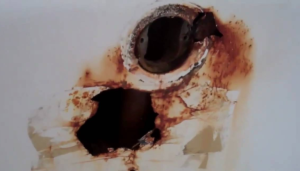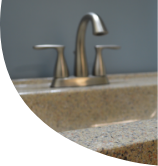3 Problems Resurfacing Can’t Fix
It’s no secret that we call bathroom and kitchen resurfacing “the smart way to remodel,” because it gives you all of the benefits of a full remodel without the hassle, mess, or price tag. According to Angie’s List, resurfacing is even estimated at less than half the cost of an average remodel! But what’s the catch? There has to be something that resurfacing can’t fix, right? Well, you’re kind of right… Although, resurfacing can remedy a plethora of issues it is important to consider that is not a guaranteed fix for everything. Because nothing is replaced the original surface must be in pretty good shape, so here are some bathroom issues we would not recommend resurfacing as a fix for…
1. Cracks in Fiberglass Shower Pans or Tubs
Fiberglass is notorious for cracking. However, it is important to note that there are two different types of cracks. The first type, and the one that CAN be repaired through resurfacing, is web-like crack formations in the surface (most often in sinks) typically caused by the gel coat drying out. This can easily be sanded down and repaired, with no real fear of the cracks returning. The second type of crack, the kind that CANNOT be remedied through resurfacing are structural cracks, and these cannot be fixed with resurfacing. With age fiberglass flexes, and with that inevitably comes stress cracks. While resurfacing can mask the appearance of the cracks for a short while, it is not recommended as a long term solution. That is because, resurfacing is a mainly cosmetic fix, and covering the structural cracks does not address the cause of them. There are some companies that have a service in which they are able to inject a pressure absorbing foam under the shower pan or tub to help prevent further damage. In cases where there is water leaking through the crack, or complete separation, we typically recommend that the shower pan or tub is replaced.

The web-like cracks in a cultured marble sink are easily remedied through our resurfacing process.

Large cracks in tubs, where separation is obvious are not good candidates for resurfacing. Our cosmetic process cannot fix structural damage.
2. Cracks in Grout Lines

Have you noticed any areas of your tile floors or walls where the grout is cracking or just won’t stay in place? Not matter how many times you replace the grout or tiles, the cracks keep forming. This could be a sign that the house is settling with age, and the shift in pressure is causing stress cracks. Although a re-grout is included in our tile resurfacing services, it is not a great way to solve your cracking grout problems. Similar to cracks in fiberglass, we are able to cover it and essentially mask the cracks but we cannot guarantee they won’t return with time. If you suspect the cracks in your walls or floor could be caused by structural stress we would not recommend resurfacing as fix.
3. Rust Coming From Behind Tub
We compare rust to cancer, in the way that we can cut it out and do our best to remove it and treat the affected area, there is no stopping rust once it has started. While resurfacing can extend the life of your rusted tub but it is not a guaranteed forever fix. Surface rust is not an issue, but tubs that need body repairs due to rusted holes or the rust is coming from underneath the tub then one should consider replacing their tub as opposed to resurfacing. If rust was an issue before the tub was resurfaced it is important to continue to monitor the damaged area for signs of rust formation. And be sure to contact your resurfacing company once you notice the rust returning so they are able to treat the problem before it becomes a larger issue.



